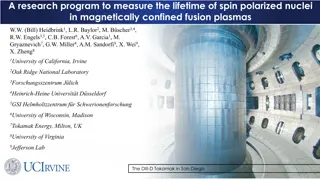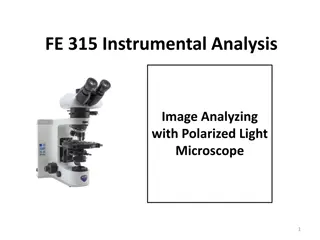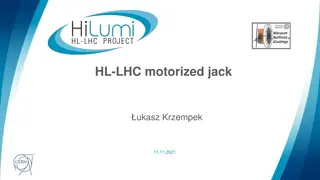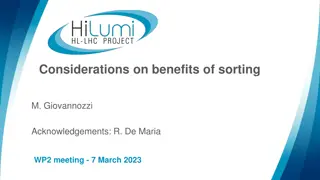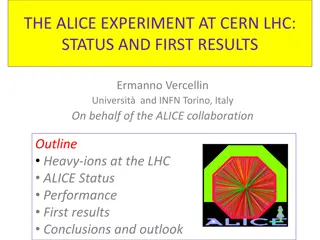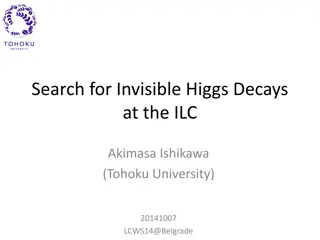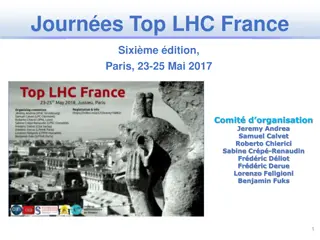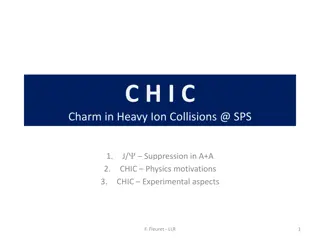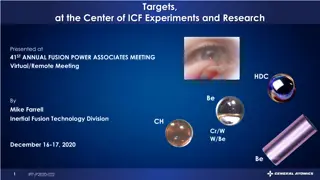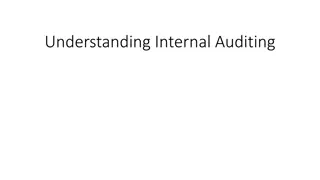Study of a Polarized Internal Target at the LHC: General Requirements and Preliminary Results
The LHCb Spectrometer at the Large Hadron Collider is exploring the design of a polarized gas target (PGT) similar to the HERMES target in the VELO alcove. The project aims to improve precision in luminosity measurements for antiproton production in colliding bunches. The new SMOG2 system with additional storage cells is approved and set for installation. The study involves optimizing the arrangement of components in the limited space available near the VELO detector. The research group is presenting preliminary ideas and results for this innovative endeavor.
Download Presentation

Please find below an Image/Link to download the presentation.
The content on the website is provided AS IS for your information and personal use only. It may not be sold, licensed, or shared on other websites without obtaining consent from the author.If you encounter any issues during the download, it is possible that the publisher has removed the file from their server.
You are allowed to download the files provided on this website for personal or commercial use, subject to the condition that they are used lawfully. All files are the property of their respective owners.
The content on the website is provided AS IS for your information and personal use only. It may not be sold, licensed, or shared on other websites without obtaining consent from the author.
E N D
Presentation Transcript
A polarized internal target at the LHC: general requirements P. Lenisa Universit di Ferrara and INFN For the LHC-spin study group P. Di Nezza (Frascati & LHCb) V. Carassiti, G. Ciullo, P. Lenisa, (INFN Ferrara) L. Pappalardo (INFN Ferrara & LHCb) E. Steffens (Erlangen) A. Vasilyev et al (Gatchina & LHCb) In collaboration with: A. Nass, R. Engels, F. Rathmann (FZ J lich) J. Depner (Erlangen) D. Reggiani, C. Baumgarten (PSI) LHC-spin kickoff meeting, Ferrara, 15.07.19
Introduction The LHCb Spectrometer detects particles from collisions at IP 8. Primary and Secondary vertices are reconstructed by the Vertex Locator (VELO). The overlap of the colliding bunches is measured via scattering on the residual gas. To increase the precision of the luminosity measurement, a gas injection system (SMOG) for Ne (He) has been added. Among several measurements, SMOG has been used for the measurement of antiproton production in pHe Fixed Target (FT) collisions [arXiv:1808.06127v1]. The LHCspin group has completed a design of an improved SMOG system with additional storage cell upstream of the VELO detector: SMOG2. It has been approved by LHCb and LHC committees, and installation will be in fall of this year 2019. As a next step, the design of a polarized gas target (PGT), similar to the HERMES target, in the VELO alcove is being studied. Preliminary ideas and results are presented here.
Arrangement in the tunnel: available space upstream of the VELO vessel Along the beam: About 1m, limited by shielding wall. Could be moved, but important for the PGT to stay as close to the VELO as possible! In transverse direction: Enough to place ABS and diagnostics in the horizontal plane ( Bguide vertcal)
Arrangement in the tunnel: view of the target area before LS2 ( 2018) In the foreground: beam tube Now with additional sector valve for temporary installation of dedicated experiments (e.g. bentcrystals ) In green: pneumatic cylinder of all-metal valve GV302/SMOG. To be replaced this shut-down by flat gate valve.
Visit at IP8 (03/2018): upstream-right Pasquale and Alexander at the Alcove Left: VELO cable rack.
Visit at IP8 (03/2018): upstream-right Side view of beam line and protective cover
Visit at IP8 (03/2018): upstream-right Beam tube (foreground) and TP 301 with valve GV 302
Visit at IP8 (03/2018): upstream-left Vito and Pasquale on the other side
Visit at IP8 (03/2018): upstream-left Erhard at the Dipole coils
Visit at IP8 (03/2018): upstream-left LHCb scaffolding
PGT topology Beam line upstream of VELO: Target Chamber Cell with beam tube (300 mm long) Gridded tube WFS 2 for differential pumping (200 mm) Tracker with 10 mm-opening Conical wake-field suppressors WFS 1 + 3. New sector valve (installed in LS2) and the entrance region of the VELO vesseL. Upstream beam tube and shielding. Opening of the elements is indicated by black arrows.
PGT topology The PGT can not be located close to or even inside the VELO vessel because of the relatively high gas flow which requires differential pumping on a separate target chamber (or with appropriate openable diaphragms in between). An analytic estimate (ES) of the peaked flow out of the downstream cell opening shows that 3 % of down-stream flow passes the 10 mm opening in the Tracker, 350 mm from cell center. For the full ABS flow, this would correspond to less than 10-6 mb l/s of recombined H , i.e. within the tolerable range. MolFlow simulations planned (including pumping by NEG coating) to calculate maximum capacity/running time. The vacuum group is worried about risks of large gas quantities and working on cryo- deposition from cold to worm transitions.
Requirements for a PGT at the LHC All narrow openings in the LHC, like the VELO detector, have to be openable during injection and tuning (rmin 27 mm at IP8). This holds for the PGT set-up as well, with cell, wake field suppressors, detectors, diaphragms etc. The design value of the PGT gas flow rate which could be 10x higher than for SMOG2, has to be fixed in a realistic range, enabling a reduction of the size of the target. Beam-induced depolarization (BID) by the bunch fields has to be suppressed by proper (non- resonant) choice of the guide field. For positive beam charge, the formation of e-clouds and the accompanying transverse instability must be prevented, i.e. the surfaces close to the beam must have low Secondary Emission Yield (SEY). The coating of these surfaces is extremely important!
Machine issues I: electron clouds Electron Cloud (EC) effects are observed in accelerators with positive particles (ions). Slow electrons produced by various ionization processes are trapped near the beam. They are accelerated by the bunches, producing Secondary Electrons which may lead to an Avalanche multiplication effect, forming dense Electron Clouds (EC). Primary slow electrons are produced on the walls and trapped in the positive beam charge. They are accelerated by the bunch fields and produce fast secondary electrons; depending on the SEY they produce a number of slow electrons By simulations: for SEY 1.5, dense EC s are formed. As a result, transverse instabilities may occur, i.e. transverse oscillations with exponential growth, resulting in dangerous beam losses.
Machine issues I: electron clouds It is evident that an elevated residual gas pressure in the target region favors EC formation, as well as chamber walls with high Secondary Electron Yield (SEY). EC formation can be analyzed by means of simulations which allow for a prediction of thresholds for the SEY below which stable beams can be expected. As coatings for surfaces close to the LHC beam, materials with SEY 1.4 are allowed, only. These are: Non-Evaporable Getter (NEG) (standard) Amorphous Carbon (a-C) (tested and applied more frequently) A NEG coating for the tube s inner surface is excluded because of its pumping action which will result in embrittlement and possible disintegration of the coating. Amorphous Carbon (a-C) is the only viable solution! Amorphous graphite is already applied in accelerators, incl. the SPS and the LHC.
Machine issues II: impedance When a beam of particles traverses a device which is not smooth or not a perfect conductor, it will produce e.m. wakefields: wakefields (in time domain) impedance (in frequency domain). Effect of e.g. impedance: Energy is lost by the beam dissipated in surrounding chambers beam induced heating! Resonant kicks to following particles instabilities beam loss and blow up! Can cause severe damage to the machine and its components, in particular in case of the LHC where a sophisticated collimator and beam dump system protects the machine. All parts installed into the LHC are carefully inspected and approved by the Impedance group using Simulations and RF measurements.
Simulation of the SMOG2 cell with gap between RF foil and cell, connected via RF contacts, but path for RF currents too long: Impedance Z (f) for direct connection (green), compared with old design (red) now improved, but not simulated, yet. The cell prototype, when ready, has to be tested with RF measurements and compared with simulations!
Open issues In a first conceptual design, the main requirements were presented and discussed: 30 cm long-cell Cold cell (100 K) coated with a-C graphite 0.3 T vertical field openable WFS system all along the beam; Tracker downstream 10 mm opening EC and Impedance problems to be simulated no show-stopper expected; Beam-induced Depolarization estimated: more favorable than at HERMES (-> ES talk) ; Target densities and lumi depend on the gas load permitted: quite high (-> ES talk).
To be solved: Cell surface with a-C coating: Effect of a-C on target polarization needs to be studied Juelich setup? Needs a thin water/ice layer to suppress recombination (and thus depolarization). Can be produced in dynamical equilibrium by injecting a low water fraction together with the polarized H atoms, set by the O2 admixture in the dissociator gas H2. The SEY of this surface is unknown: needs to be studied. Which dissociator technology with extreme reliability to be used? No coolant must flow into the vacuum system Space is tight, in particular on the side of the beam foreseen for diagnostics. How would a minimal BRP and TGA look like? Is there a pp channel we could use for polarimetry? see RHIC jet polarimeter detecting recoil p s from CNI region? NICA is also planning a similar polarimeter How to enable assembly, service and repair within the limited space?



